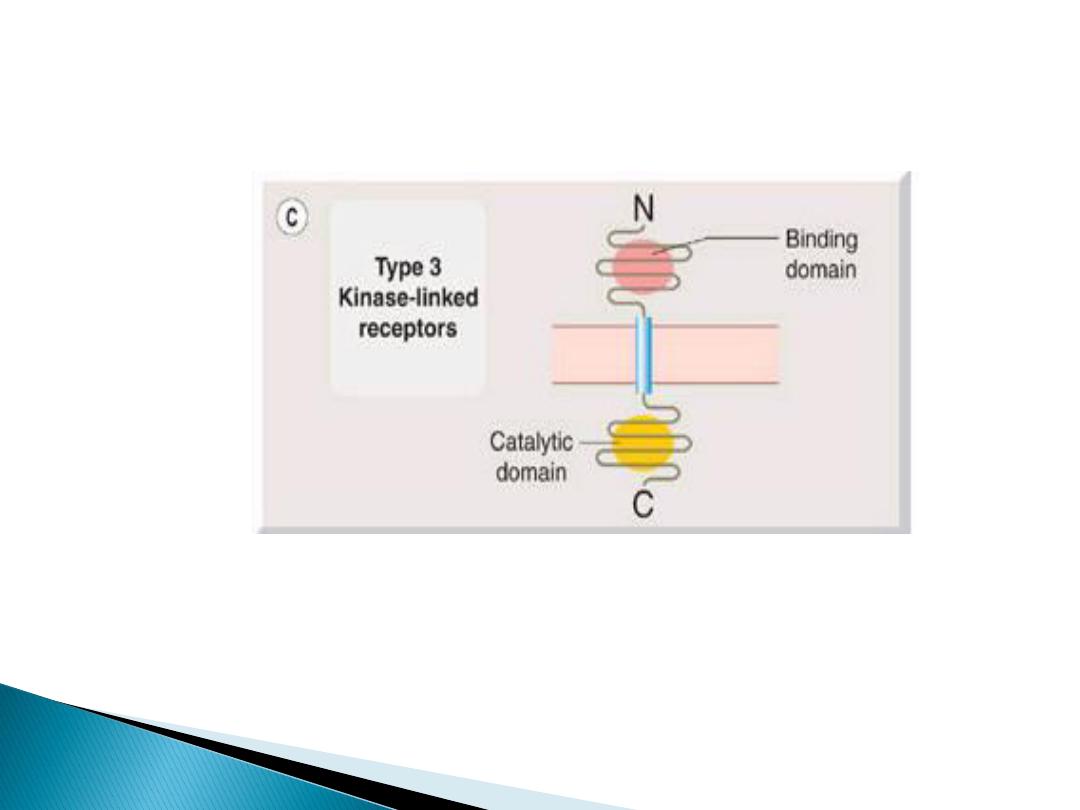
Dr.Dlawer A.AL Jaff
PhD Pharmacology and Toxicology

Pharmacology can be defined as the study of
substances that interact with living systems
through chemical processes, especially by
binding
to
regulatory
molecules
and
activating or inhibiting normal body
processes.
These
substances
may
be
chemicals
administered
to
achieve
a
beneficial
therapeutic effect on some process within the
patient or for their toxic effects on regulatory
processes in parasites infecting the patient.

A drug may be defined as any substance that
brings about a change in biologic function
through its chemical actions.
In the great majority of cases, the drug
molecule interacts with a specific molecule in
the biologic system that plays a regulatory
role. This molecules called a receptor.
Toxicology is the branch of pharmacology
that deals with the undesirable effects of
chemicals on living systems, from individual
cells to humans to complex ecosystems

In order to interact chemically with its
receptor, a drug molecule must have the
appropriate size, electrical charge, shape, and
atomic composition.
Furthermore, a drug is often administered at
a location distant from its intended site of
action, eg, a pill given orally to relieve a
headache

Therefore, a useful drug must have the necessary
properties to be transported from its site of
administration to its site of action.
Finally, a practical drug should be inactivated or
excreted from the body at a reasonable rate so
that its actions will be of appropriate duration.
A placebo is any component of therapy that is
without specific biological activity for the
condition being treated.
Placebo medicines are used for two purposes:
• As a control in scientific evaluation of drugs
• To benefit or please a patient, not by any
pharmacological actions but by psychological
means
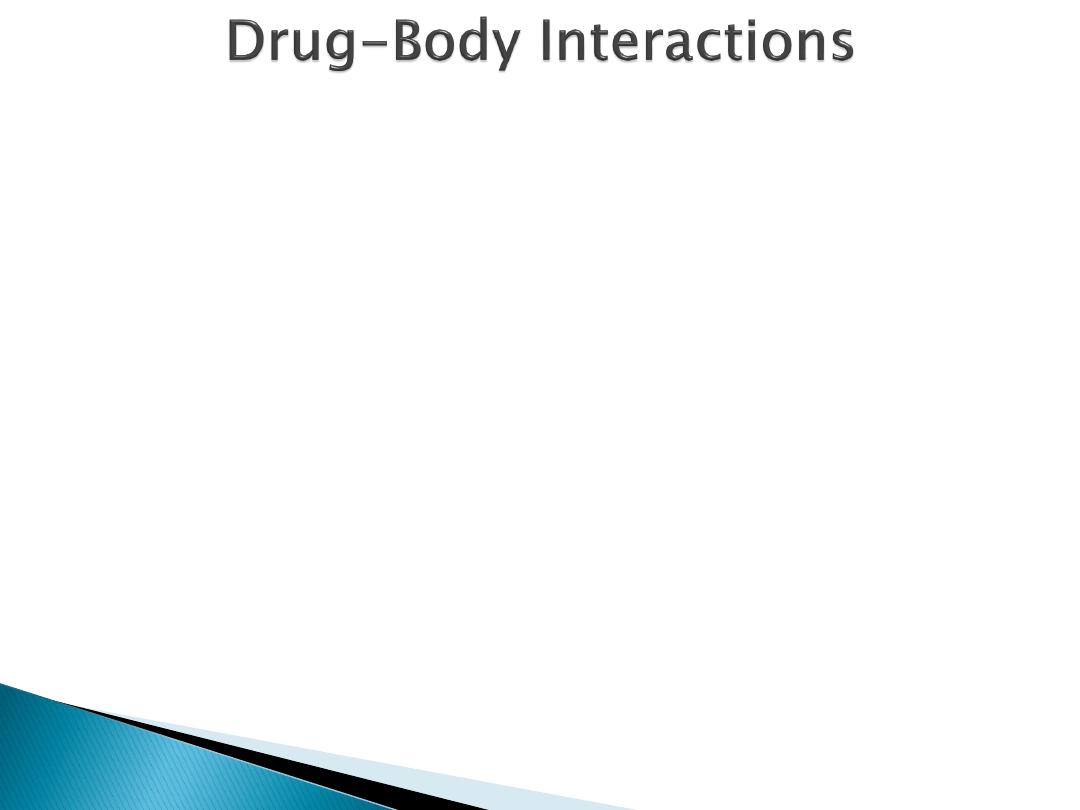
The interactions between a drug and the body
are conveniently divided into two classes. The
actions of the drug on the body are termed
pharmacodynamic processes
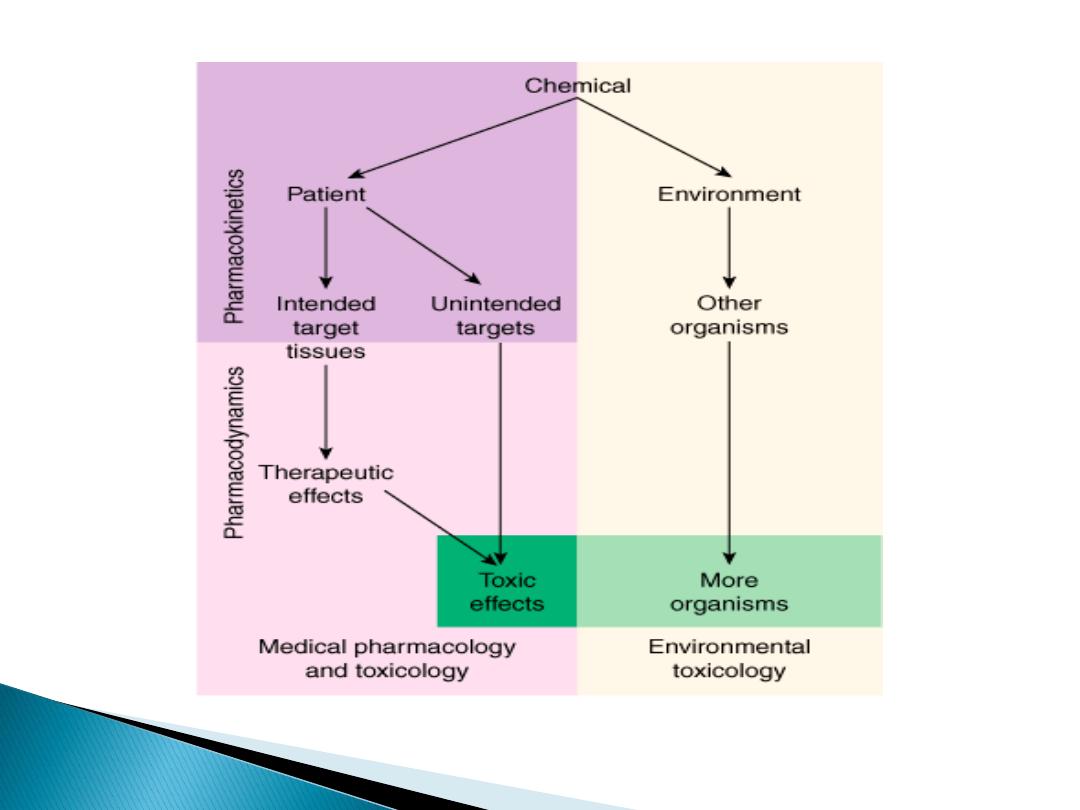

• Qualitative aspects: Receptors, Enzymes,
Selectivity
• Quantitative aspects: Dose response,
Potency, Therapeutic efficacy, Tolerance

pharmacokinetic
Pharmacokinetic processes govern the •
Time course of drug concentration: Drug
passage across cell membranes; Order of
reaction; Plasma half-life and steady-state
concentration; Therapeutic drug monitoring
•
Individual
processes:
Absorption,
Distribution, Metabolism, Elimination
•
Drug dosage: Dosing schedules

• Individual or biological variation: Variability
due to inherited influences, environmental
and host influences
• Drug interactions: outside the body, at site
of absorption, during distribution, directly on
receptors, during metabolism, during
excretion

MECHANISMS
drugs act on the cell membrane by:
• Action on
specific receptors,
e.g. agonists and
antagonists
on
adrenoceptors,
histamine
receptors, acetylcholine receptors
• Interference with selective
passage of ions
across membranes,
e.g. calcium entry (or
channel)
blockers
• Inhibition of membrane bound
enzymes and
pumps,
e.g. membrane bound ATPase by cardiac
glycoside; tricyclic antidepressants block the
pump by which amines are actively taken up from
the exterior to the interior of nerve cells.
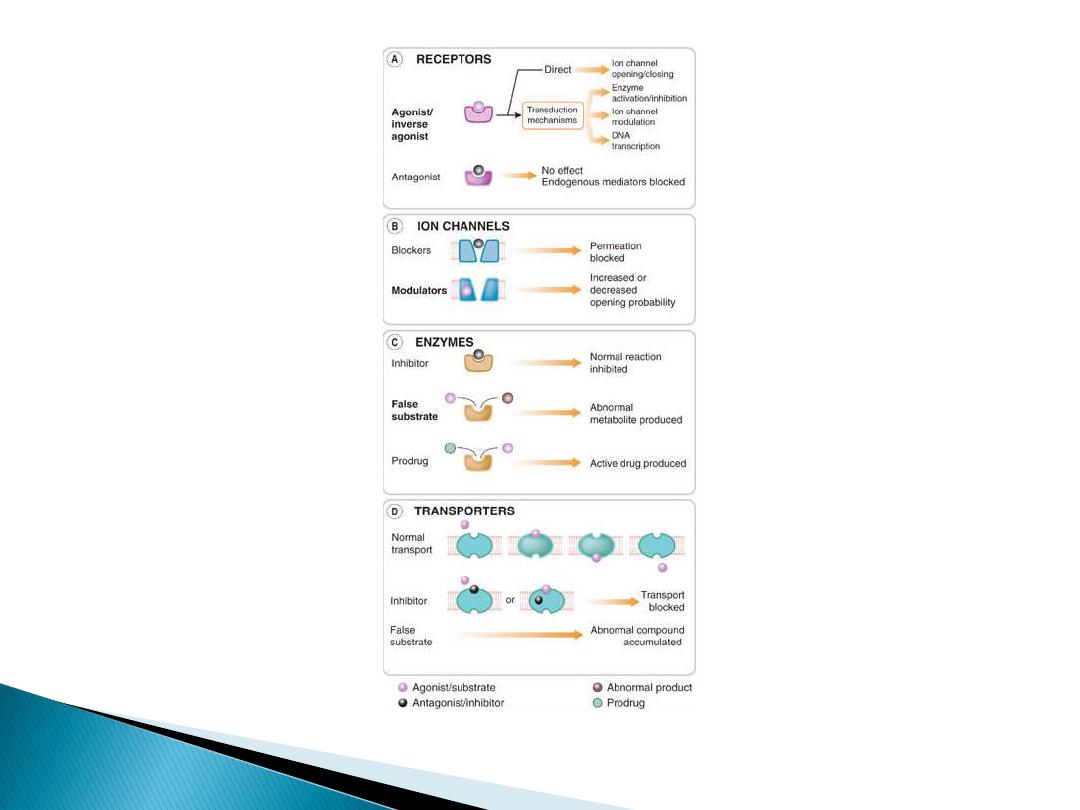

Drugs act on metabolic processes within the cell
by:
•
Enzyme inhibition,
e.g. platelet cyclo-
oxygenase by aspirin, cholinesterase by
pyridostigmine, xanthine oxidase by allopurinol
• Inhibition of
transport processes
that carry
substances across cells, e.g. blockade of anion
transport in the renal tubule cell by probenecid
can be used to delay excretion of penicillin, and
to enhance elimination of urate
•
Incorporation into larger molecules,
e.g. 5-
fluorouracil, an anticancer drug, is incorporated
into messenger-RNA in place of uracil

• In the case of successful
antimicrobial
agents, altering metabolic processes unique
to microorganisms e.g. penicillin interferes
with formation of the bacterial cell wall, or by
affecting a process common to both humans
and microbes, e.g. inhibition of folic acid
synthesis by trimethoprim.

Drugs act outside the cell by:
•
Direct chemical interaction,
e.g. chelating
agents, antacids
•
Osmosis,
as
with
purgatives,
e.g.
magnesium sulphate, and diuretics, e.g.
mannitol, which are active because neither
they nor the water in which they are dissolved
are absorbed by the cells lining the gut and
kidney tubules respectively.

Four main kinds of regulatory protein are
commonly involved as primary drug targets,
namely:
receptors
enzymes
carrier molecules (transporters)
ion channels.
There are some exceptions, particularly
among the new generation of
biopharmaceutical drugs
. Furthermore, many
drugs bind (in addition to their primary
targets) to plasma proteins and other tissue
proteins, without producing any obvious
physiological effect

RECEPTORS
Most receptors are protein macromolecules.
When the agonist binds to the receptor, the
proteins
undergo
an
alteration
in
conformation which induces changes in
systems within the cell that in turn bring
about the response to the drug
Receptors are the sensing elements in the
system of chemical communications that
coordinates the function of all the different
cells in the body, the chemical messengers
being the various hormones, transmitters and
other mediators .

A. Ligand-gated ion channels
The first receptor family comprises ligand-gated ion
channels that are responsible for regulation of the
flow of ions across cell membranes .
The activity of these channels is regulated by the
binding of a ligand to the channel.
Response to these receptors is very rapid, having
durations of a few milliseconds. The nicotinic
receptor and the Gaba aminobutyric acid (GABA)
receptor are important examples of ligand-gated
receptors, the functions of which are modified by
numerous drugs.
Stimulation of the nicotinic receptor by acetylcholine
results in sodium influx, generation of an action
potential, and activation of contraction in skeletal
muscle. Benzodiazepines, on the other hand, enhance
the stimulation of the GABA receptor by GABA,
resulting
in
increased
chloride
influx
and
hyperpolarization of the respective cell
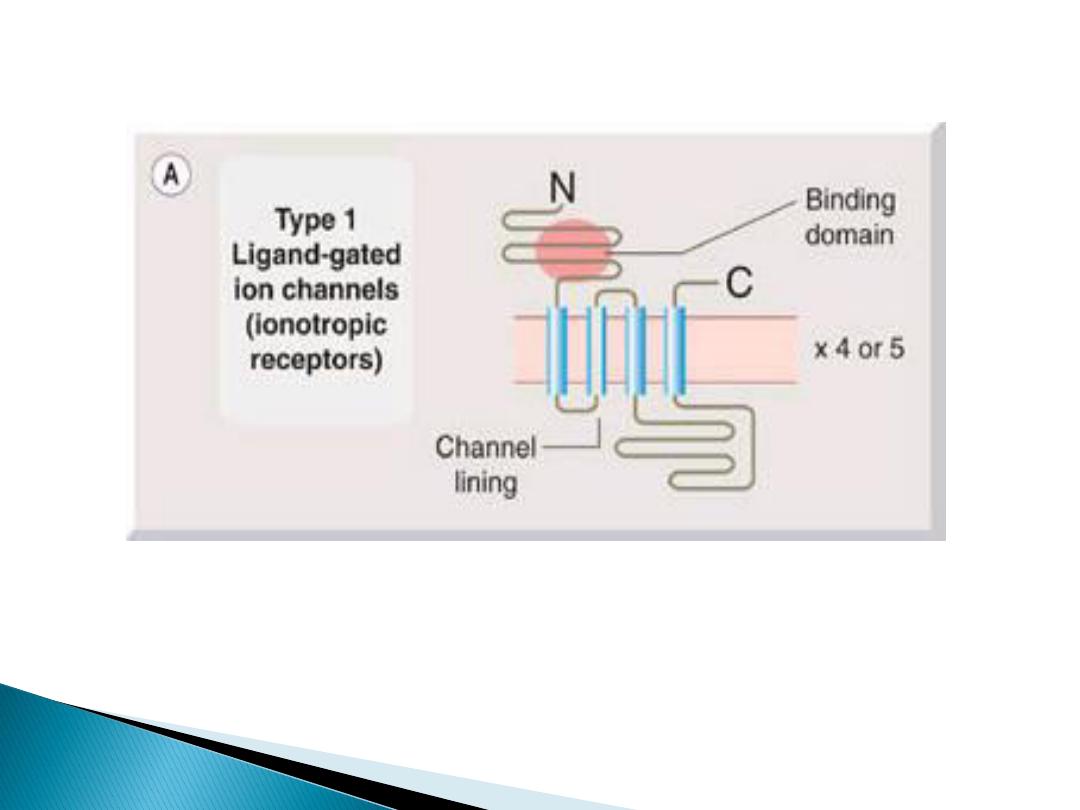

B. G protein coupled receptors
A second family of receptors consists of G
protein coupled receptors. These receptors are
comprised of a single peptide that has seven
membrane-spanning
regions,
and
these
receptors are linked to a G protein (Gs and
others)
that binds guanosine triphosphate (GTP). Binding
of the appropriate ligand to the extracellular
region of the receptor activates the G protein so
that GTP replaces
guanosine diphosphate (GDP) . Dissociation of
the G protein occurs, and both the-GTP subunit
and the subunit subsequently interact with other
cellular effectors, usually an enzyme or ion
channel.

These effectors then change the
concentrations of second messengers that
are responsible for further actions within the
cell. Stimulation of these receptors results in
responses that last several seconds to
minutes.
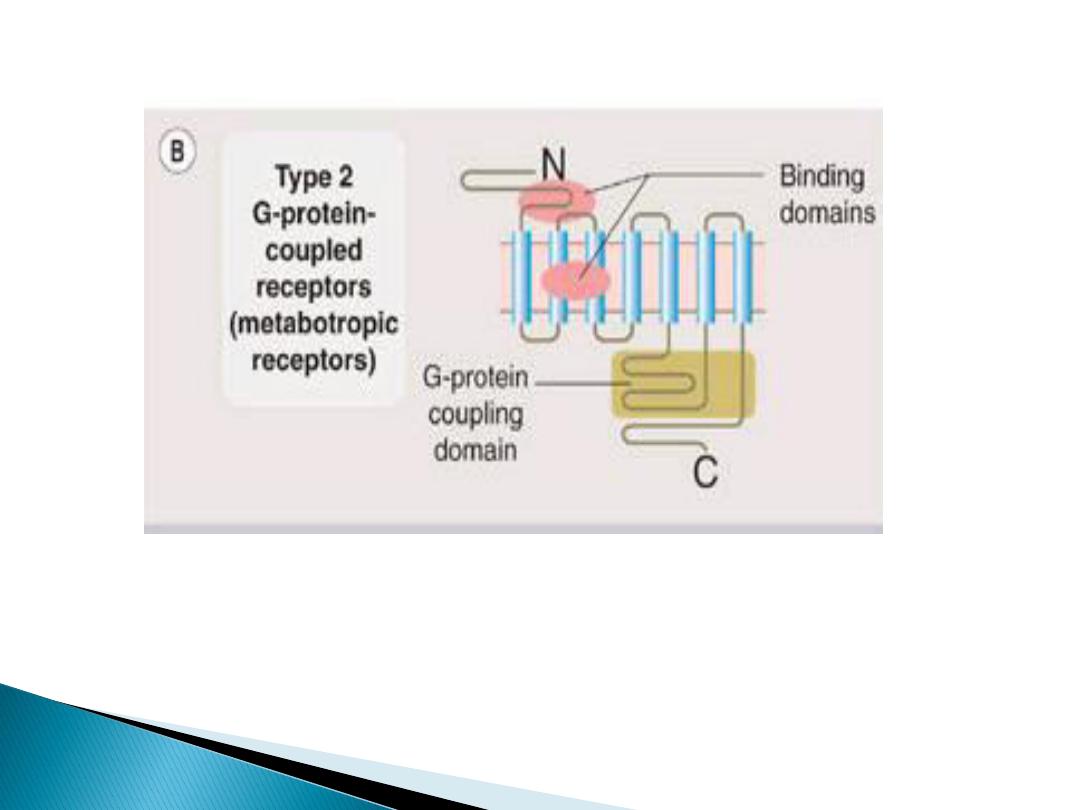

C. Enzyme-linked receptors
A third major family of receptors consists of
those having cytosolic enzyme activity as an
integral component of their structure or function.
Binding of a ligand to an extracellular domain
activates or inhibits this cytosolic enzyme
activity.
Duration of responses to stimulation of these
receptors is on the order of minutes to hours.
The most common enzyme-linked receptors
(epidermal
growth
factor,
platelet-derived
growth factor, atrial natriuretic peptide, insulin,
and others) are those that have a tyrosine kinase
activity as part of their structure.

Typically, upon binding of the ligand to
receptor subunits, the receptor undergoes
conformational changes, converting from its
inactive form to an active kinase form. The
activated receptor autophosphorylates,
andphosphorylates tyrosine residues on
specific proteins. The addition of a phosphate
group can substantially modify the three-
dimensional structure of the target protein,
thereby acting as a molecular switch.

For example, when the peptide hormone
insulin binds to two of its receptor subunits,
their intrinsic tyrosine kinase activity causes
autophosphorylation of the receptor itself. In
turn,
the
phosphorylated
receptor
phosphorylated target moleculesâ
€”insulin-
receptor
substrate
peptides
”that
subsequently activate other important cellular
signals such as IP3 and the mitogen-activated
protein kinase system.
